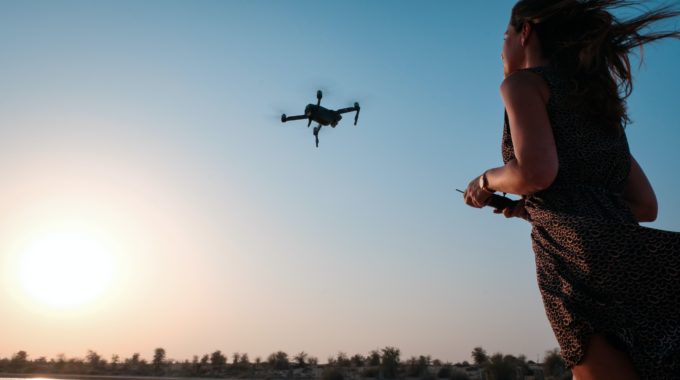
New Technologies for Advanced Content Marketing
Today’s consumers walk around with a million ads in their pockets. A recent study found that they see over 5,000 advertisements each day. The average person doesn’t notice most of the ads they encounter: they can’t. If they did, they’d probably start to question their sanity.
Because there are more ads than ever before, it’s even more difficult to cut through the noise to reach your target customer. You already know that content marketing is one of the ways you can do just that. Using advanced content marketing tactics will not only reach out and grab customers, but also high-quality posts keep them on your site and engage them. After all, you don’t just want their attention, you want customer loyalty.
New technologies are making it easier to connect with customers on a more personal level. Tech like AI and drone video footage reaches through customers’ computers and grabs them by the collar. What’s more, much of that tech is accessible even to small companies. You just need to know where to look.
How AI Will Make Advanced Content Marketing More Personal
Personalization is a top priority in marketing because consumers now expect it. Statistics from Epsilon, a pioneer in data-driven marketing, show that 80% of consumers are more likely to buy from brands that personalize their experiences. Fortunately, tools like predictive intelligence can help. Predictive intelligence, or predictive , uses AI to monitor customer behavior and builds profiles to identify what they will do next—and when.
How does it work in content? Predictive intelligence understands the demands of individual customers and delivers the content that meets their needs. It gives you better insight into what to send to each customer and a more intimate understanding of the buyer journey for each group. It makes planning and prioritizing content more efficient and ensures you send out the right message at exactly the right time.
Unfortunately, AI tools like predictive intelligence won’t do all the grunt work for you. Market research and customer outreach are still your responsibility. But AI will likely help you refine your strategies, which is critical. As AI progresses more generally, your target market will become even more accustomed to having unique experiences online than they are today. Your ability to deliver that experience is the difference between stagnation and growing your business. AI will help you make sense of the data to help you complete market research and market segmentation more intelligently.
After your campaign ends, AI then analyzes its performance not only based on your own metrics but by comparing you to your closest competitors. These platforms already exist in content intelligence tools, and they can help each new campaign outpace the last one.
Drone Content Grabs Your Customers’ Attention
There’s no doubt about it: video is the king of content. Marketers spent $90.7 billion on video development in 2018, and Forrester says they’ll spend $102.8 billion per year by 2023. In the 4K Instagram-first world, everyone’s looking for a unique perspective to outshine the rest. Drone content has quickly filled that space, and some of what it produces is magical. The travel niche, in particular, has enjoyed a renaissance. While selfie spots and painted walls have become tired, drone footage is as unique as the operator who controls the perspective from high above the clouds.
Drones came along at precisely the right time because video is the top-performing type of content across social media even on Twitter. A tweet with a video generates 10 times more engagement than a tweet with an image or text. Pinterest is also driving purchases through brand video content. And of course, Instagram, once the home of the selfie, is now the king of video with not one, not two, but four ways of sharing videos with followers. Aside from the traditional way of simply uploading a video to your Instagram feed, you can add videos to your Stories, which expire after 24 hours. You can also broadcast on Instagram Live. And last but certainly not least is IGTV, Instagram’s long-form video sharing that allows for a video snippet to post to your Instagram feed and link to IGTV for followers to watch the rest. IGTV is Instagram’s answer to YouTube.
The benefits of using drones are almost unlimited. You can not only use them for aerial shots but also for fast action motion shots. You can also now create HD and 4K footage so you never miss a second. Plus, you can creatively direct and physically direct all of your videos: your marketing team’s vision can be executed by them rather than relying on the whims of an outside camera team. Flying a drone is also easy to learn, and the products are so cheap that you’ll even save money compared to full camera crews.
Live Streaming Puts You In Customers’ Homes
How powerful is live streaming? Statistics say 80% of consumers prefer live videos from a brand than a blog post and 82% prefer it to social posts. While it relies on established technology, live streaming has only been perfected in the last few years. What’s more, the arrival of 5G networks will only help live streaming grow: consumers have a low tolerance for a laggy stream and will close the window after 90 seconds of a poor connection.
The big benefit of live streaming is the direct engagement it generates. When an account goes live on Instagram, the video creator can chat with the viewers in real-time as platforms like Instagram allow you to not only chat but also to add audience members into videos for real engagement. It’s the kind of conversation that social media promised to be before timelines and feeds ultimately became too cluttered to offer meaningful engagement on an everyday basis.
At the same time, live streaming can veer from game-changing to cringeworthy quickly. Remember that those effortless content creators you’ve seen on your personal feeds are seasoned pros. To make the most of the tech, you need to find and then become your authentic (brand) self.
Once you’re ready to start streaming, remember that casual video environments tend to work best for these events. While you do need a script, you also need to strike a balance and avoid relying on it throughout the video. That’s why it’s important to use live streaming to share important messages that are central to your brand. For example, Dunkin’ Donuts, known as Dunkin’ by its friends, used live streaming to promote its National Donut Day. Rather than doing something hokey, the brand brought its customers behind the scenes of the Dunkin’ test kitchen.
Ultimately, you don’t need to treat your live stream like it’s a sitcom. Focus on keeping it simple and showing off your brand.
Virtual Reality puts You in Customers’ Heads
While food and beverage marketing has found its sweet spot — who doesn’t want to look at pictures of food on their social media feeds? — alcohol has had a bumpier road to increased profits and social media stardom. Alcohol companies can’t be seen marketing to teens, and what’s more, many companies have old, stuffy brand images that don’t translate well to social media. Marketing wine, for example, is particularly challenging because so few brands have a distinct commercial image that helps them stand out on image-heavy platforms like Instagram.
While alcohol producers are limited by marketing standards, they’re also some of the most appreciative of two new technologies: augmented reality (AR) and virtual reality (VR). They’re using AR and VR apps to tell the stories of their brands and create memorable experiences for consumers to differentiate themselves from the competition.
Glenfiddich, a well-established Scotch whiskey brand, is particularly keen on the experience. It has international name recognition, but its setting in the remote Scottish Highlands makes it a difficult brand to engage with both in-person and online. To combat this problem, the company brought itself closer to its customers with its Virtual Reality Distillery Tours, which it deployed at bars and in retail environments back in 2016. William and Grant Sons, another behemoth in the Scotch whiskey world, uses an AR app to share cocktails and gamify its brand experience.
If you want to cut through the noise, advanced content marketing requires more than a great hook and sleek photographs. Today, technologies like AI, drone technology, and AR/VR give you a chance to target your content directly to individual customers and show them a perspective they’ve never seen before. All you need to do is figure out what they want to see.
Beau Peters is a creative professional with a lifetime of experience in service and care. As a manager, he’s learned a slew of tricks of the trade that he enjoys sharing with others who have the same passion and dedication that he brings to his work.



